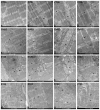Vegan Red: A Safer Alternative to Synthetic Food Dyes?
- PMID: 40559920
- PMCID: PMC12196790
- DOI: 10.3390/toxics13060447
Vegan Red: A Safer Alternative to Synthetic Food Dyes?
Abstract
Food colourants are widely used additives classified as either synthetic or natural. In recent years, consumers have increasingly favoured natural options, considering them safer and potentially beneficial due to their nutritional properties. This study examined the effects of a natural food colourant, commercially known as Vegan Red (RVEG), on zebrafish embryonic development. Its impact was compared with cochineal red E120, of animal origin, and the synthetic dye E124, which are associated with hyperactivity in children and allergies. Shield stage embryos were exposed for 72 h and then examined using a multidisciplinary approach to assess the effects on conventional toxicity endpoints, such as survival, hatching rate, heart rate, genotoxicity, and behavioural interferences, including the impact on muscle ultrastructure. The results demonstrated that RVEG, as well as E120, do not affect hatching, heart rate, and motility parameters. However, RVEG moderately alters skeletal muscle organisation and, more relevant, the expression of the gfap, chchd2, and notch1a genes. Based on standard toxicity parameters, the findings indicated that RVEG is less toxic than E124 and E120, but that the alterations induced in gene expression and muscle anatomy raise safety concerns.
Keywords: E120; E124; behaviour; gene expression; muscle ultrastructure; toxicity; vegan red; zebrafish embryos.
Conflict of interest statement
The authors declare that they have no conflicts of interest.
Figures






Similar articles
-
Home treatment for mental health problems: a systematic review.Health Technol Assess. 2001;5(15):1-139. doi: 10.3310/hta5150. Health Technol Assess. 2001. PMID: 11532236
-
Signs and symptoms to determine if a patient presenting in primary care or hospital outpatient settings has COVID-19.Cochrane Database Syst Rev. 2022 May 20;5(5):CD013665. doi: 10.1002/14651858.CD013665.pub3. Cochrane Database Syst Rev. 2022. PMID: 35593186 Free PMC article.
-
Systemic pharmacological treatments for chronic plaque psoriasis: a network meta-analysis.Cochrane Database Syst Rev. 2017 Dec 22;12(12):CD011535. doi: 10.1002/14651858.CD011535.pub2. Cochrane Database Syst Rev. 2017. Update in: Cochrane Database Syst Rev. 2020 Jan 9;1:CD011535. doi: 10.1002/14651858.CD011535.pub3. PMID: 29271481 Free PMC article. Updated.
-
A rapid and systematic review of the clinical effectiveness and cost-effectiveness of paclitaxel, docetaxel, gemcitabine and vinorelbine in non-small-cell lung cancer.Health Technol Assess. 2001;5(32):1-195. doi: 10.3310/hta5320. Health Technol Assess. 2001. PMID: 12065068
-
Synthetic and Natural Red Food Dyes Affect Oxidative Metabolism and the Redox State in the Nauplii of Brine Shrimp Artemia franciscana.Antioxidants (Basel). 2025 May 25;14(6):634. doi: 10.3390/antiox14060634. Antioxidants (Basel). 2025. PMID: 40563270 Free PMC article.
References
-
- Zingue S., Mindang E.L.N., Awounfack F.C., Kalgonbe A.Y., Kada M.M., Njamen D., Ndinteh D.T. Oral Administration of Tartrazine (E102) Accelerates the Incidence and the Development of 7, 12-Dimethylbenz (A) Anthracene (DMBA)-Induced Breast Cancer in Rats. BMC Complement. Med. Ther. 2021;21:1–11. doi: 10.1186/s12906-021-03490-0. - DOI - PMC - PubMed
LinkOut - more resources
Full Text Sources
Miscellaneous

